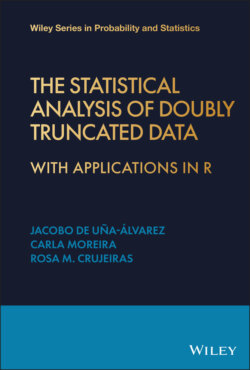Читать книгу The Statistical Analysis of Doubly Truncated Data - Prof Jacobo de Uña-Álvarez, Prof Carla Moreira - Страница 12
1 Introduction 1.1 Random Truncation
ОглавлениеRandom truncation generally refers to a situation in which a number of individuals of the target population cannot be sampled because a certain random event precludes them. When this random event is unrelated to the variables of interest standard statistical methods apply, with the only inconvenience of using a smaller sample size. In many practical cases, however, the truncation event is related to the variables under study, and specific methods to overcome the sampling bias must be considered.
This book is focused on random truncation phenomena that arise (usually, but not only) when sampling time‐to‐event data. That is, the variable of interest is the time elapsed from a well‐defined origin to another well‐defined end point. In this setting, a truncated sample of is a set of independent and identically distributed (iid) random variables with the conditional distribution of given , where is a random set. Since the truncation event is obviously related to , standard statistical methods applied to the truncated sample may be systematically biased. For example, the ordinary empirical cumulative distribution function (ecdf) of at point , , converges to rather than to the target cumulative distribution function (cdf) . This problem has received remarkable attention since the seminal paper by Turnbull (1976). Special forms of truncation when sampling time‐to‐event data are reviewed in Sections 1.2 and 1.3.
Time‐to‐event data are relevant in fields like Survival Analysis and Reliability Engineering, in which random truncation often occurs. Random truncation is found in Astronomy too, where represents the luminosity of an stellar object that is subject to observation limits. Examples from these areas will be introduced and analysed throughout this book.
